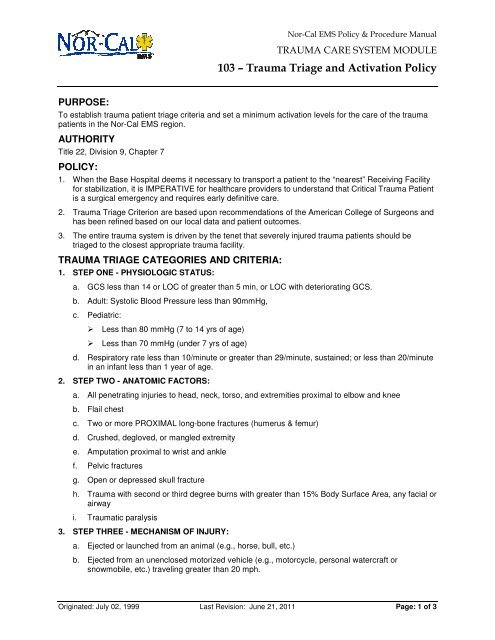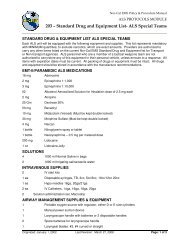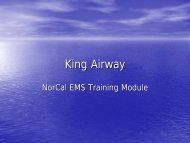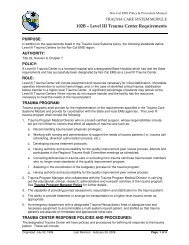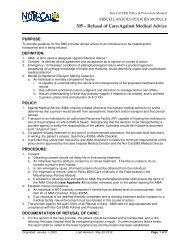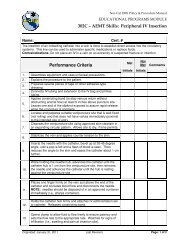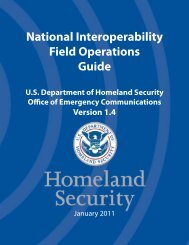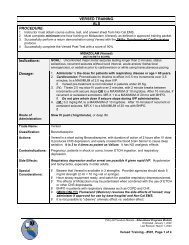103 – Trauma Triage and Activation Policy
103 – Trauma Triage and Activation Policy
103 – Trauma Triage and Activation Policy
Create successful ePaper yourself
Turn your PDF publications into a flip-book with our unique Google optimized e-Paper software.
Nor-Cal EMS <strong>Policy</strong> & Procedure Manual<br />
TRAUMA CARE SYSTEM MODULE<br />
<strong>103</strong> <strong>–</strong> <strong>Trauma</strong> <strong>Triage</strong> <strong>and</strong> <strong>Activation</strong> <strong>Policy</strong><br />
PURPOSE:<br />
To establish trauma patient triage criteria <strong>and</strong> set a minimum activation levels for the care of the trauma<br />
patients in the Nor-Cal EMS region.<br />
AUTHORITY<br />
Title 22, Division 9, Chapter 7<br />
POLICY:<br />
1. When the Base Hospital deems it necessary to transport a patient to the “nearest” Receiving Facility<br />
for stabilization, it is IMPERATIVE for healthcare providers to underst<strong>and</strong> that Critical <strong>Trauma</strong> Patient<br />
is a surgical emergency <strong>and</strong> requires early definitive care.<br />
2. <strong>Trauma</strong> <strong>Triage</strong> Criterion are based upon recommendations of the American College of Surgeons <strong>and</strong><br />
has been refined based on our local data <strong>and</strong> patient outcomes.<br />
3. The entire trauma system is driven by the tenet that severely injured trauma patients should be<br />
triaged to the closest appropriate trauma facility.<br />
TRAUMA TRIAGE CATEGORIES AND CRITERIA:<br />
1. STEP ONE - PHYSIOLOGIC STATUS:<br />
a. GCS less than 14 or LOC of greater than 5 min, or LOC with deteriorating GCS.<br />
b. Adult: Systolic Blood Pressure less than 90mmHg,<br />
c. Pediatric:<br />
Less than 80 mmHg (7 to 14 yrs of age)<br />
Less than 70 mmHg (under 7 yrs of age)<br />
d. Respiratory rate less than 10/minute or greater than 29/minute, sustained; or less than 20/minute<br />
in an infant less than 1 year of age.<br />
2. STEP TWO - ANATOMIC FACTORS:<br />
a. All penetrating injuries to head, neck, torso, <strong>and</strong> extremities proximal to elbow <strong>and</strong> knee<br />
b. Flail chest<br />
c. Two or more PROXIMAL long-bone fractures (humerus & femur)<br />
d. Crushed, degloved, or mangled extremity<br />
e. Amputation proximal to wrist <strong>and</strong> ankle<br />
f. Pelvic fractures<br />
g. Open or depressed skull fracture<br />
h. <strong>Trauma</strong> with second or third degree burns with greater than 15% Body Surface Area, any facial or<br />
airway<br />
i. <strong>Trauma</strong>tic paralysis<br />
3. STEP THREE - MECHANISM OF INJURY:<br />
a. Ejected or launched from an animal (e.g., horse, bull, etc.)<br />
b. Ejected from an unenclosed motorized vehicle (e.g., motorcycle, personal watercraft or<br />
snowmobile, etc.) traveling greater than 20 mph.<br />
Originated: July 02, 1999 Last Revision: June 21, 2011 Page: 1 of 3
TRAUMA CARE SYSTEM MODULE <strong>Trauma</strong> <strong>Triage</strong> <strong>and</strong> <strong>Activation</strong> <strong>Policy</strong> # <strong>103</strong><br />
c. High risk auto crash:<br />
Intrusion: greater than 12 inches, occupant site; greater than 18 inches intrusion, any site.<br />
Ejection (partial or complete) from automobile<br />
Death in same passenger compartment<br />
Extrication time greater than 20 minutes<br />
Rollover without a seatbelt<br />
d. Falls:<br />
Adults: greater than 20 feet; (1 story = 10 ft.)<br />
Pediatrics: falls greater than 10 feet or 2 to 3 times the height of the child<br />
e. Auto vs. pedestrian / bicyclist thrown, run over, or with significant (greater than 20mph) impact.<br />
4. STEP FOUR - AGE &/OR COMORBIDITIES/SYSTEM CONSIDERATIONS:<br />
a. Age <strong>and</strong>/or Co-Morbidity Factors:<br />
Age 5 years or younger <strong>and</strong> difficult to evaluate or age greater than 55 years<br />
Anticoagulation <strong>and</strong> bleeding disorders<br />
End-stage renal disease requiring dialysis<br />
Pregnancy greater than 20 weeks<br />
Morbid Obesity<br />
b. System Considerations:<br />
EMS Provider Judgment<br />
Burns without other trauma mechanism: triage to burn facility<br />
Time sensitive extremity injury<br />
PATIENT DESTINATION DECISIONS:<br />
Guidelines for the trauma patient destination decision are outlined in <strong>Policy</strong> # 307 Patient Destination<br />
<strong>Policy</strong>, located in the Miscellaneous Policies Module. Physicians at <strong>Trauma</strong> Centers <strong>and</strong> Receiving<br />
Facilities in the Nor-Cal EMS region, shall base destination decisions on this policy.<br />
TEAM NOTIFICATION:<br />
The <strong>Trauma</strong> Center shall make all necessary Emergency Department <strong>Trauma</strong> Resuscitation Team <strong>and</strong> (if<br />
applicable) <strong>Trauma</strong> Team notifications, including the trauma surgeon, if not greater than three (3) minutes<br />
from the initial trauma alert from prehospital personnel.<br />
<strong>Trauma</strong> Alert <strong>Trauma</strong> <strong>Activation</strong> (Resuscitation <strong>and</strong>/or <strong>Trauma</strong> Team Notification) less than<br />
three (3) minutes<br />
TRAUMA TEAM CONFIGURATIONS:<br />
1. A ED <strong>Trauma</strong> Resuscitation Team:<br />
a. Includes the following team members:<br />
A Qualified Specialist (ED physician)<br />
Emergency Department nurses<br />
Scribe<br />
Laboratory technician<br />
Radiology technologist<br />
Originated: July 02, 1999 Last Revision: June 21, 2011 Page: 2 of 3
TRAUMA CARE SYSTEM MODULE <strong>Trauma</strong> <strong>Triage</strong> <strong>and</strong> <strong>Activation</strong> <strong>Policy</strong> # <strong>103</strong><br />
b. May include the following team members:<br />
Respiratory Therapy<br />
Critical care nurse(s)<br />
Security officers<br />
Chaplain or social worker<br />
2. A <strong>Trauma</strong> Team (if applicable at the <strong>Trauma</strong> Center) includes the following team members:<br />
a. General Surgeon<br />
b. Anesthesiologist (CRNA if waiver has been approved at the State)<br />
c. Operating Room Staff<br />
MINIMUM ACTIVATION CRITERIA:<br />
1. Tier I <strong>Activation</strong>:<br />
a. A Tier I <strong>Activation</strong> shall be called for patients meeting the definition of Critical <strong>Trauma</strong> Patient.<br />
A Critical <strong>Trauma</strong> Patient is defined as a patient meeting on of the following <strong>Trauma</strong> <strong>Triage</strong><br />
Categories:<br />
(1) Physiologic Status<br />
(2) Anatomical Factors<br />
A patient who meets the definition above <strong>and</strong> is transferred to the same or higher level<br />
trauma center <strong>and</strong> did not receive an evaluation by a trauma surgeon at the sending<br />
Receiving Facility.<br />
2. Tier II <strong>Activation</strong>:<br />
a. At a minimum, shall be activated for patients meeting one of the following <strong>Trauma</strong> <strong>Triage</strong><br />
Categories:<br />
Mechanism of Injury coupled with Age <strong>and</strong>/or Co-Morbidity Factors<br />
Mechanism of Injury<br />
b. May be activated at a Level III or Level IV <strong>Trauma</strong> Center for a Critical <strong>Trauma</strong> Patient when the<br />
predetermined plan for care is immediate stabilization <strong>and</strong> transfer out to higher level <strong>Trauma</strong><br />
Center or Specialty Center.<br />
c. May be activated for trauma patients who have been transferred in from another <strong>Trauma</strong> Center<br />
<strong>and</strong> already received a surgical evaluation from a trauma surgeon at the sending facility.<br />
3. Physician discretion to activate or not activate the <strong>Trauma</strong> Team, when the patient meets one of the<br />
following <strong>Trauma</strong> <strong>Triage</strong> Criteria categories:<br />
a. Age <strong>and</strong> or Co-Morbidity Factors<br />
b. System Considerations<br />
EMERGENCY DEPARTMENT ONLY PATIENT:<br />
1. This occurs when the patient was not identified as meeting <strong>Trauma</strong> <strong>Triage</strong> Criteria <strong>and</strong> no specific<br />
response was initiated. This level of care is only considered appropriate when the physician did not<br />
activate a <strong>Trauma</strong> Team for a trauma patient who ONLY met either Age &/or Co-Morbidity Factors or<br />
System Considerations. The physician plan of action shall be documented in the chart.<br />
2. After an initial assessment, the Emergency Department Physician may decide to downgrade a<br />
<strong>Trauma</strong> Team <strong>Activation</strong> to an Emergency Department ONLY Patient. This decision shall be<br />
documented in the patient chart; otherwise it will be considered a failure to activate.<br />
ASSOCIATED POLICIES:<br />
This policy is incorporated in the BLS <strong>Trauma</strong> <strong>Triage</strong> Decision Scheme, ALS <strong>Trauma</strong> <strong>Triage</strong> Decision<br />
Scheme, Patient Destination <strong>Policy</strong>, <strong>and</strong> the individual <strong>Trauma</strong> Center Requirement policies.<br />
Originated: July 02, 1999 Last Revision: June 21, 2011 Page: 3 of 3


